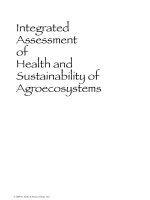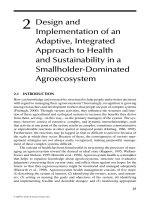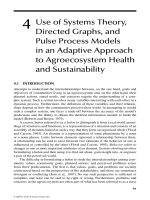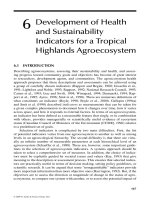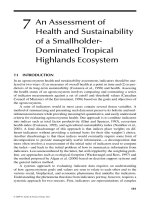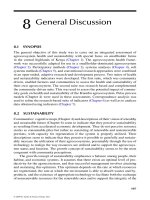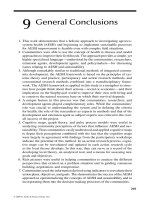Integrated Assessment of Health and Sustainability of Agroecosystems - Chapter 5 pptx
Bạn đang xem bản rút gọn của tài liệu. Xem và tải ngay bản đầy đủ của tài liệu tại đây (1.27 MB, 19 trang )
127
5
Soft System Methodology
in the Management of
Agroecosystem Health
and Sustainability
Concerns of a Tropical
Highlands Agroecosystem
5.1 INTRODUCTION
Hard system methods (also known as rst-order cybernetics) are concerned with
problem situations in which there is correspondence between the holon and things
or phenomena in the real world. Soft system methods (second-order cybernetics),
on the other hand, deal with situations in which such correspondence may not exist,
with the holons articulated solely for the purpose of understanding and as shorthand
for the mental framework of an individual with a unique experiential or cognitive
history on the relevant real-world situation (Ison et al., 1997).
The objectives of a soft system analysis in agroecosystem health (AESH) and
sustainability assessment are threefold. The rst is to reveal the different, and some-
times conicting, perspectives of stakeholders and the rationale behind each percep-
tion of a problem situation. This prepares the ground for mutual understanding and
negotiation among the stakeholders, a prerequisite to any sustainable improvements.
The second objective is to serve as the basis for evaluating potential management
options. As the agroecosystem evolves over time, new aspects of the messy prob-
lem situation emerge, requiring new analysis and synthesis as well as rethinking the
management options. The third objective is the evaluation of agroecosystem perfor-
mance. This can be done by comparing and contrasting holon characteristics over
time and space.
Several soft system approaches have been proposed (Flood and Carson, 1993),
but the best documented is soft system methodology (SSM). SSM is a set of orga-
nized principles—based on systems thinking—that guide action in trying to manage
messy problem situations. SSM follows two interacting modes of inquiry that together
lead to the implementation of changes to improve the situation. One of these, the
cultural stream, consists of three examinations of the problem situation (Checkland
and Scholes, 1990). The rst examines the intervention itself. The second examines
the situation as a social system; the third examines it as a political system. The basic
© 2009 by Taylor & Francis Group, LLC
128 Integrated Assessment of Health and Sustainability of Agroecosystems
step in the second (logic-based) mode of inquiry is to formulate models, which it is
hoped will be relevant to the real-world situation (Checkland and Scholes, 1990). The
models are then compared with various perceptions of the real world, thus initiating
debates and a process of negotiations and trade-offs that lead to purposeful actions
aimed at improving the problem situation under scrutiny.
SSM uses particular kinds of holons—referred to as human activity systems—to
model the problem situation. A human activity system is a set of named activities
connected to make a purposeful whole (Checkland and Scholes, 1990). The holons
are conceived as holistic ideal types of certain aspects of the problem situation
rather than as accounts of it; it is taken for granted that no objective and complete
account of a messy problem situation can be given (Bulow, 1989). Two kinds of
human activity systems can be made: the primary task system and the issue-based
system (Checkland and Wilson, 1980). Primary task systems are ones in which the
elements and relationships map on to real-world institutionalized arrangements.
Issue-based systems, on the other hand, are relevant to mental processes that are not
embodied in formalized real-world arrangements. The distinction between primary
task and issue-based systems is not absolute but rather more of opposite ends of a
spectrum. The choice of a human activity system to represent a problem situation is
always subjective (Checkland and Scholes, 1990), with the nal choice depending on
which model is deemed most relevant to the situation after the logical implications
of all the choices have been evaluated.
A human activity system is built based on its root denition. A root deni-
tion expresses the core purpose of an activity system. That core purpose is always
expressed as a transformation process in which some entity, the “input,” is changed,
or transformed, into some new form of that same entity, the “output.” The trans-
formation occurs because a purposeful action (or actions) A is (or are) taken on
that entity. Such an action, being purposeful, will be an expression of the intention
of some person or persons B. Since A is a human action, there will be someone C
who takes the action. The action will have an impact on some person or group D,
and it will be taking place in an environment E, which may place constraints on it.
Since human autonomy is rarely total, there may be a person or group F who could
stop the action being taken. In real life, the same person or persons could be one or
more of the elements in B, C, D, or F since these represent roles and not individuals
or groups playing them. The transformation and the actions taken are meaningful
and rational given a particular perspective or worldview. A complete root denition
of a human activity system therefore identies the customer (D), the actor (C), the
transformation, the worldview, the owner (B), and the environment of a particular
activity system.
Several human activity systems can be built to represent different perspectives
of a given world situation. In addition, activity systems can be built for intended
purposeful actions, with several such systems representing the different perspec-
tives that may exist among all the stakeholders. These models then serve as the
basis for negotiation and consensus building as well as a guide to action, monitoring,
and evaluation. This chapter describes how SSM was used to manage the analysis,
design, and implementation of purposeful actions to ameliorate AESH and sustain-
ability concerns in the intensive study sites (ISSs).
© 2009 by Taylor & Francis Group, LLC
Soft System Methodology in the Management of Agroecosystems 129
5.2 PROCESS AND METHODS
5.2.1 e
x A m i n A t i o n o f t h e pr o b l e m si t u A t i o n s
Problems and concerns in the agroecosystem were identied and described during
participatory workshops in each of the six study sites. The participatory process
is described in Chapter 3; the process of selecting the study sites is described in
Chapter 2. Problem, concerns, and issues were termed messy situations if there were
disagreements on the nature of the problem, its causes, historical background, or
potential solutions.
Semistructured interviews were held with groups and individuals in the com-
munity having a different perspective on the issue. Table 5.1 shows a checklist of the
topics covered in the interviews. Any institution, group, or individual mentioned by
interviewees (in relation to the problem situation) were also included in the list of
those to be interviewed. The perspectives of each group were captured in rich pic-
tures with different color lines showing agreement or disagreement among various
groups or individuals.
5.2.2 ro o t De f i n i t i o n s A n D so f t sy s t e m mo D e l i n g
For each problem situation, primary task and issue-based human activity systems
were identied based on the coping strategies and the opportunities mentioned by
the individuals or groups interviewed. Root denitions of these systems were then
derived and models built to satisfy the basic properties of a system as described by
Checkland and Scholes (1990). A root denition was derived for each stakeholder
with a different perspective on the problem situation. Different metaphors, based on
the roles, norms, and values ascribed to various stakeholders, were used to represent
each different perspective on the issue. For each model representing a purposeful
TABLE 5.1
List of Topics Covered in Semistructured Interviews on a Problem Situation
Sequence Topic Subtopic
1. Beginning Historical
background
How the problem arose
Who is/are the most knowledgeable person(s) on the issue
What are some of the consequences that have been observed
Nature of
problem
Causes
Effects
2. Mid Opportunities How can the problem be addressed
What resources are needed
What are the coping strategies
3. End Stakeholders Who are/should be the actors in solving the problem
Who are/should be the beneciaries
Who are/should be the owners of the process
What is the relationship between owners, actors, and beneciaries
Who is to blame or are involved in causing the issue
What has been the role of (named) stakeholder in the situation
© 2009 by Taylor & Francis Group, LLC
130 Integrated Assessment of Health and Sustainability of Agroecosystems
action, the monitoring and control unit was identied. Measures of performance,
based on what the effects and the causes of the problem were perceived to be, were
listed together with their targets and thresholds.
5.2.3 bu i l D i n g Co n s e n s u s , Co m p r o m i s e , A n D Co l l e C t i v e AC t i o n
The rich pictures and models were presented to the different groups or individuals
rst separately and then together. Participants were asked to comment on the accu-
racy of the opinions depicted and what the implications appeared to be. Participants
were informed that there was opportunity to change any aspect of the models or
depictions that represented their own ideas. Changes in the models or depictions
were effected, with the participants required to state whether the changes they
requested were a change in their opinion (or view or perspective), a compromise, or
simply correction of an error in the depiction of their views. Where all participants
were present, models were presented as the views and opinions of the facilitator
on the problem situation. Criticism of the models and depictions by the community
and other stakeholders were therefore directed to the facilitator and not to the group
whose ideas were depicted. The identity of the groups or individuals whose views
were depicted in a model was not revealed to other stakeholders bearing a different
view.
5.3 RESULTS
5.3.1 p
r o b l e m si t u A t i o n s
5.3.1.1 Drainage and Access Road Problems in Kiawamagira
During the rainy season and every time it rained for a few hours, most of the land
in Kiawamagira became ooded. Furthermore, the runoff was too much and had
created big gullies in various places in the village and along the only access road to
the village. The consequences were that the village was inaccessible at such times,
crops were destroyed, and soil productivity was declining. Plate 5.1 is a photograph
taken in October 1997 (shortly after the village workshop) showing one of the gullies
caused by runoff in Kiawamagira village. Plate 5.2 shows the state of the access road
during this time. Plate 5.3 shows one of the outlets passing under the railway line that
directs runoff to Kiawamagira village.
Figure 5.1 is a rich picture depicting the various perspectives of different groups
within the community and of other stakeholders. There were three main competing
perspectives on the causes of ooding, gully formation, and destruction of the access
road. The rst was that the redirected runoff from the railway and road was the main
cause. The course of action, according to this perspective, was to take the institutions
involved in the redirecting of runoff to court with a view to compelling them to act.
Figure 5.2 shows the root denition and an activity system based on this perspective.
The second perspective was that it was the farmers who had redirected the runoff
from the farms to the access road, resulting in damage and gully formation along the
waterways. Based on this, the course of action was to cooperate as a village and nd
ways and means of redirecting the runoff away from the village. The root denition
© 2009 by Taylor & Francis Group, LLC
Soft System Methodology in the Management of Agroecosystems 131
based on this perspective is shown in Figure 5.3. The third was that the area was a
swamp before settlement and therefore prone to ooding. The proposed action was
therefore to nd means of preparing the community to better cope with ooding and
damage (Figure 5.4).
5.3.1.2 Gitangu Water Project
According to the participants in the initial village workshop, the Gitangu water proj-
ect was initiated as a self-help project by the community in Ngecha Sublocation,
Limuru Division, in Kiambu district in 1962. The project drew water from Gitangu
springs located within Gitangu village and pumped it, using an electric pump, to
two water reservoirs in the sublocation, one of which was in Gitangu village. The
project was taken over by the Ministry of Water Development in 1965. The minis-
try was the main manager until 1980, when the pump and other accessories were
PLATE 5.1 One of the gullies in the Kiawamagira intensive study site, Kiambu district,
Kenya, October 1997.
PLATE 5.2 Damaged access road to the Kiawamagira intensive study site, Kiambu district,
Kenya, October 1997.
© 2009 by Taylor & Francis Group, LLC
132 Integrated Assessment of Health and Sustainability of Agroecosystems
vandalized, leading to the collapse of the project. The project was then handed back
to the community, and a committee, including members from the entire subloca-
tion, was selected to revive it. To the time of this study, this had not been successful.
Key
Solid arrows = agreement; Dashed arrows = disagreement
FIGURE 5.1 Differing perspectives on the drainage and access road problems in Kiawama-
gira village. See CD for color image.
6859(<25
³«VWRSSDVVLQJWKHEXFN´
5$,/:$<$'0,1,675$7,21
³«UDLOZD\ZDVWKHUHEHIRUH«
OHWWKHPVXH´
0=((1-252*(
³«QHHGWRXQGHUVWDQGWKHGUDLQDJH
V\VWHPRIWKHDUHD«WKHURDGUDLOZD\
DQGQHLJKERULQJYLOODJHDUHLQYROYHG´
)$50(5
³HURVLRQLVGXHWRUXQRII
IURPWKHUDLOZD\´
$'0,1,675$7,21
³«WKH\MXVWZDQWWRFDXVHWURXEOH«
WKHSUREOHPKDVDOZD\VEHHQWKHUH´
9,//$*($&7,9,67
(17+86,$67
³«FRRSHUDWH«ZRUNWRJHWKHU«
ZHFDQVROYHWKHSUREOHPRXUVHOYHV´
9,//$*()$7$/,67
³ODQGZDVVZDPS\EHIRUHZHVHWWOHG«
WKHUHLVQRWKLQJZHFDQGR´
62,/&216(59$7,21$*(176
«PRVWRIWKHVWUXFWXUHVVWLOOWKHUH
«ZHFDQUHYLYHWKHSURMHFW«
9,//$*(/(*$/($*/(
³ZHZLOOVXHWKHUDLOZD\´
5$,/:$<(1*,1((5
³«ODQGGHPDUFDWLRQ
VXUYH\RU¶VPLVWDNHV«´
38%/,&:25.6
³«QRDOWHUQDWLYHV«FDQQRWDOORZ
UXQRIIWRGHVWUR\WKHURDG´
%86,1(663(23/(
³IDUPHUVGHVWUR\WKHURDGE\
GLUHFWLQJUXQRIIWRLW´
PLATE 5.3 One of the outlets (white arrow) passing under the railway line (on ridge) and
directing runoff into the Kiawamagira intensive study site, Kiambu district, Kenya, October
1997.
© 2009 by Taylor & Francis Group, LLC
Soft System Methodology in the Management of Agroecosystems 133
Figure 5.5 depicts the differing perspectives of various stakeholders on the Gitangu
water project. The three main perspectives with regard to the course of action were
(1) do nothing, (2) rehabilitate the project, and (3) start a new project (to sink a
borehole).
C: Clients; A: Actors; T: Transformations; W: World-view; O: Owners; E: Environment
FIGURE 5.2 A root denition and an activity system based on the perspective of farmers to
ameliorate ooding and damage to the access road in the Kiawamagira intensive study site.
KR, Kenya Railways; MoPW, Ministry of Public Works. See CD for color image.
MoPW
Redesign drainage
around roads and
railway
Village committee
Obtain expertise
to design drainage
system in village
Harmonize designs
ImplementRepair access road
Monitor to decide if:
-runoff to village is reduced
-there are blockages
-there are breakdowns
-access road usable
Take action
It is the runoff from the roads and railway that
overloads the drainage system of the village
W:
O:
Kiawamagira community, MoPW, KR
E:
Goodwill from MoPW and KR, Resources from MoPW and KR,
community organization, and unity
C: Kiawamagira community
A:
MoPW, KR
T:
Runoff directed
into village
Runoff directed
away from village
A system, owned by Kiawamagira community, together with the MoPW
and KR to rehabilitate the drainage system in and around Kiawamagira
village in order to reduce flooding, gully formation, and access road
damage, using resources from the MoPW, KR, and Kiawamagira
communities.
KR
© 2009 by Taylor & Francis Group, LLC
134 Integrated Assessment of Health and Sustainability of Agroecosystems
5.3.1.3 Inadequate Extension Services in Kiambu District
According to participants in the initial workshops, government extension agents
visited most of the villages in Kiambu district and demonstrated modern farming
techniques. This became less and less frequent beginning from the late 1980s and
C: Clients; A: Actors; T: Transformations; W: World-view; O: Owners; E: Environment
FIGURE 5.3 A root denition and an activity system based on the perspective of a group
of business people and those with off-farm employment in the Kiawamagira intensive study
site. See CD for color image.
A system, organized by the Ministry of Agriculture (MoA), together with
farmers in Kiawamagira village to design, implement, and maintain proper
drainage of farms using resources provided by the ministry and residents
of Kiawamagira village.
C:
A:
T:
W:
O:
E:
Kiawamagira community
MoA, Kiawamagira community
Runoff directed
to access road
Runoff directed away
from access road
Farmers direct runoff from their farms to the access road
causing damage and flooding in other areas of the village
Kiawamagira community
Expertise from MoA, Resources from Kiawamagira community,
community organization and unity, goodwill from farmers
MoA
Design drainage
system
Farmers
Village committee
Organize and
obtain resources
Implement
Monitor to decide if:
-runoff to road is reduced
-road in good condition
Take action
Repair road
© 2009 by Taylor & Francis Group, LLC
Soft System Methodology in the Management of Agroecosystems 135
was almost nonexistent in the late 1990s. There were three main perspectives on the
causes of this. The rst was that the Ministry of Agriculture could no longer afford to
nance such activities. The second was that farmers in many of the villages were too
resistant to the extension agents, resulting in disillusionment. The third perspective
C: Clients; A: Actors; T: Transformations; W: World-view; O: Owners; E: Environment
FIGURE 5.4 A root denition and an activity based on the perspective of a group of com-
munity members collectively referred to as the fatalists. See CD for color image.
C:
A:
T:
W:
O:
E:
A system, organized by the residents of Kiawamagira village, to reduce the
negative impacts of flooding and damage to access road during the rainy
season using resources available to each of the households in the village.
Kiawamagira community
Kiawamagira community
Suffering resulting from flooding
and access road damage
Suffering reduced
Lack of adequate preparation during the rainy season increases
suffering when the floods come and the access road is damaged
e village is predisposed to flooding and nothing can be done
about that
Kiawamagira community
Resources available to households, community organization
Households
Stock supplies
Village committee
Plant blue gum trees
in swampy areas
Support
those most
affected
Monitor to decide:
-Who most affected
-Recovery and damage
control
Keep community
alert and informed
Control damage
and facilitate
recovery
Take action
Organize
community
© 2009 by Taylor & Francis Group, LLC
136 Integrated Assessment of Health and Sustainability of Agroecosystems
was that the extension system was inefcient, with the extension agents spending
time doing other things or providing the services to those villages and communities
that they favored (Figure 5.6).
5.3.1.4 Community Inertia in Kiambu District
Participants in the workshop were asked why, given that they were aware of the
problems facing their village, they had not taken any action. There were two main
perspectives. The rst was that the government was responsible, and that it deals
with issues at its own convenience. The second main perspective was that commu-
nity leaders were ineffective for various reasons, meaning that people tried to resolve
problems as individuals (Figure 5.7).
5.3.2 bu i l D i n g Co n s e n s u s A n D ro o t De f i n i t i o n s
Figure 5.8 shows the change in perspectives of the various stakeholders on the ood-
ing and access road problem in Kiawamagira village after viewing the completed
rich picture of the problem situation. Similar changes in perspectives occurred in
all other problem situations in which the approach was used. Table 5.2 shows the
activities, measures of performance, and targets negotiated to resolve four of the
problem situations faced by communities in the six ISSs. In the situations, communi-
ties began the implementation process immediately after the rst rich pictures were
Key
Solid arrows = agreement; Dashed arrows = disagreement
FIGURE 5.5 Differing perspectives on Gitangu water project in Gitangu village. NGO,
nongovernmental organization. See CD for color image.
0,1,675<2):$7(5
«ZDVZRUNLQJZKHQZHSXOOHGRXW«
«ZDVHVVHQWLDOO\DFRPPXQLW\SURMHFW
«ZHRQO\SURYLGHGH[SHUWLVH
$'0,1,675$7,21
«WKH\PLVPDQDJHGWKH\DUH
LJQRUDQW«GRQRWNQRZKRZWRUXQD
SURMHFW«
32/,7,&,$16
«GLIILFXOWSHRSOH«H[SHFW
PDQQDIURPKHDYHQ«
'21256$*(1&,(61*2V
«DUHQRWSRRURIWKHSRRU«
LVQRWRXUPDQGDWH«GRQRWIXQG
FRPPXQLW\VROLFLWHGSURMHFWV
7,5('
«ZHKDYHEHHQFKHDWHGFRXQWOHVV
7LPHV«ZHDUHMXVWWLUHGRIFRQWULEXWLQJ
DQGQHYHUVHHLQJUHVXOWV«DOOZHJHWDUH
SURPLVHV
&+$1*(
«IRUJHWDERXWWKHSURMHFW«
VLQNDFRPPXQLW\ERUHKROH«
)$7$/,67
«SROLWLFLDQVDUHVHOILVK«WKH
DGPLQLVWUDWLRQLJQRUHVXV«WKRVH
ZKRFDQKHOSXVGRQ¶WFDUH«ZH
DUHSRRU«ZHVKRXOGQRWH[SHFW
DQ\EHWWHU«
237,0,67
«PRVWRIWKHVWUXFWXUHVVWLOOWKHUH
«ZHFDQUHYLYHWKHSURMHFW«
7+(%/$0(
«WKHPLQLVWU\RIZDWHUSHRSOHDUH
WREODPH«WKH\ZHUHWKHRQHV
UHVSRQVLEOH«
,*125$1&(
«ZHGLGQRWNQRZZKDWZDV
UHTXLUHGRIXV«WKDWZHZHUH
WKHRQHVUHVSRQVLEOH
/(6621/($51('
«ZHNQRZEHWWHU«ZHDUHWKH
RQHVUHVSRQVLEOH«RXUZHOO
EHLQJLQRXURZQKDQGV«
© 2009 by Taylor & Francis Group, LLC
Soft System Methodology in the Management of Agroecosystems 137
drawn, proceeding based on their action plans. In the case of Kiawamagira village,
the activities undertaken to repair the access road were followed by severe drainage
and gully formation, resulting in an even worse road condition. Plate 5.4 shows the
condition of the road in November 1997, at 1 month after the initial workshops.
Stones from the nearby quarry were put in place to ll the gullies, but the runoff was
still directed toward the village and its access road.
5.3.3 im p l e m e n t A t i o n , mo n i t o r i n g , A n D ev A l u A t i o n
In Kiawamagira village, negotiations were carried out with the Kenya Railway and
with the Ministry of Public Works in Kiambu. Both pledged material support as well
as expertise as requested. The community was to raise the initial funds to start the
work. The AESH project provided an engineer, who designed a drainage system.
The Ministry of Agriculture provided staff and support in the management of soil
erosion and gullies. The implementation of the drainage system has not yet been
implemented. This was attributed to the inability to raise the required funds, the
death of two of the key committee members, and the emigration of the commit-
tee chairman. Attempts to raise funds and implement the project are still ongoing.
Plate 5.5 shows the success of the soil conservation measures on one of the gullies
in the village.
Key
Solid arrows = agreement; Dashed arrows = disagreement
FIGURE 5.6 The perspectives of various stakeholders on the causes of inadequate exten-
sion services in the district. See CD for color image.
)(('%$&.
«WKH\GRQRWOLVWHQWR
ZKDWZHKDYHWRVD\«
WKH\WKLQNWKH\NQRZ
HYHU\WKLQJ
5(6,67$1&(
«PDQ\RIWKHVHIDUPHUV
DUHWRRUHVLVWDQW«WKH\
WULYLDOLVHPDQ\JRRGLGHDV
,55(/(9$1&(
«0DQ\RIWKHWKLQJVWKH\
WHDFKXVDUHLUUHOHYDQWRU
QRWDSSOLFDEOHWRRXU
VLWXDWLRQ
7+($*(&$5'
«VRPHRIWKHVHSHRSOHDUH
WRR\RXQJWREHWHDFKLQJ
XV
27+(5%866,1(66
«H[WHQVLRQDJHQWVDUHWRR
EXV\ZLWKRWKHUWKLQJV«
QHYHUPDNHIDUPYLVLWV«
5(6285&(&$5'
«ZHKDYHVHYHUH
EXGJHWDU\FRQVWUDLQWV«
WKHWUDLQLQJDQGYLVLWVDUH
H[SHQVLYH
9$/8(
«VRPHRQHWROGXVWKDW
RQHGD\ZHZLOOSD\WR
KDYHWKHVHVHUYLFHV
'(3(1'(1&<
«IDUPHUVKDWHLWZKHQZH
GRQRWKDYHLWHPVWR
GLVWULEXWHIRUIUHH
7+()5217/,1(
«ZHKDYHDUHVLGHQW
H[WHQVLRQDJHQWIRUHDFK
ORFDWLRQ
7,5('
«QRWUDQVSRUW«QRWHYHQ
DELF\FOH«WRRWLUHGWR
DFKLHYHPXFK
'(021675$7(
«QHHGWRGHPRQVWUDWH«
3UDFWLFDODSSOLFDWLRQ«
© 2009 by Taylor & Francis Group, LLC
138 Integrated Assessment of Health and Sustainability of Agroecosystems
In Gitangu village, the community raised 800,000 Kenya shillings and pur-
chased a new pump. They obtained further nancial support from Plan International
to purchase a booster pump, build a bigger tank, and rehabilitate the piping sys-
tem. Water kiosks are being built at strategic points in the village, while plans are
under way to purchase water meters and to provide piped water to most homesteads.
Plate 5.6 shows community members preparing the site for the new water tank. In the
background is the old water tank that was to be rehabilitated and used as the treat-
ment unit for the new water supply system. Plate 5.7 shows work being carried out to
rehabilitate the piping system.
Communities in all six villages organized meetings with extension agents to
discuss various topics. In most of the cases, the meetings were organized and funded
by the communities, but in some cases, the initiative came from the extension agents
following the presentation of community action plans to the divisional extension
staff. In all cases, topics to be covered were selected in consultation with the commu-
nities. Plate 5.8 shows an extension agent demonstrating the use of various energy-
saving devices in Kiawamagira village.
Plate 5.9 shows a group of leaders from the six ISSs at the end of a 6-day residen-
tial training workshop on leadership and community mobilization together with some
members of the AESH multidisciplinary team. At this workshop, leaders developed
Key
Solid arrows = agreement; Dashed arrows = disagreement
FIGURE 5.7 Perspectives of community leaders in the intensive study site on the inability
to act on problems affecting their agroecosystems. See CD for color image.
5(63216,%,/,7<
«JRYHUQPHQW
UHVSRQVLEOH«
6:,1'/('
«ZHFRQWULEXWHPRQH\
WRZDUGVDFDXVH«
PLVDSSURSULDWHG
%86<%2',(6
«WKH\FDOOXVEXV\
ERGLHV«IRROV«
$&&2817$%,/,7<
«OHDGHUVGRQRWOLNHWR
EHTXHVWLRQHG«RU
SURYLGHLQIRUPDWLRQ
&2//(&7,9(,1(57,$
«D*LNX\XVD\LQJ«RQO\D
IRROZLOOH[KDXVWKLPVHOIRQ
DFFRXQWRISXEOLFJRRG
'(3(1'(1&<
«LIJRYHUQPHQWKDVQR
PRQH\LWFDQDSSO\WR
GRQRUV«
329(57<
«WRRSRRUWRKDYHDQ\
LPSDFW«
,*125$1&(
«ZHGRQRWNQRZPXFK«
WKHVHWKLQJVDUHGLIILFXOWWR
XQGHUVWDQG«
,1',9,'8$/
«HYHU\SHUVRQVKRXOG
FDUU\KLVRZQFURVV«
&2//(&7,9($&7,21
«D*LNX\XVD\LQJ«
XQLW\LVVWUHQJWK«
.12:/('*(
«KRZWRFRQGXFWRXU
DIIDLUV«HIIHFWLYH
OHDGHUVKLS«PDQDJHPHQW
,17+(,5+$1'6
«WKHJRYHUQPHQWZLOO
GRWKLQJVZKHQLWGHHPV
LWILWWRGRVR«
',)),&8/7
«SHRSOHDUHGLIILFXOW«HYHQ
0RVHVIRXQGLWGLIILFXOWWR
OHDGWKH,VUDHOLWHV«QHYHU
VDWLVILHG
,*125('
«QRRQHOLVWHQVWRWKH
SRRU«WKHSRRUKDYHQR
YRLFH
© 2009 by Taylor & Francis Group, LLC
Soft System Methodology in the Management of Agroecosystems 139
the intervillage monitoring and evaluation program. Plate 5.10 shows an intervillage
evaluation meeting in Githima village. Included in this meeting were ofcials of the
International Institute for Rural Reconstruction (IIRR) as observers.
5.4 DISCUSSION
5.4.1 s
o f t sy s t e m mo D e l s
The rich pictures were instrumental in helping communities to see the different per-
spectives that existed on a problem situation. In many cases, they elicited laughter
and a softening of stance by the various protagonists. By creating root denitions
based on the various perspectives, researchers were able to make communities focus
on the strength and weakness of each perspective, thereby generating an opportunity
for synthesis, negotiation, and compromise.
The main difculty with the process is that it took time to build the rich pictures
and root denitions, while the communities preferred to start with the implementa-
tion process almost immediately after the initial village workshops. Many of these
attempts resulted in failure and frustration on their part. How the process can be
Key
Solid arrows = agreement; Dashed arrows = disagreement
FIGURE 5.8 Changing perspectives of various stakeholders on the ooding and access
road problem in Kiawamagira village. See CD for color image.
6859(<25
³«VWRSSDVVLQJWKHEXFN´
5$,/:$<$'0,1,675$7,21
³«HQJLQHHUVFDQSURYLGHWHFKQLFDO
DGYLFHRQGUDLQDJH´
0=((1-252*(
³«QHHGWRXQGHUVWDQGWKHGUDLQDJH
V\VWHPRIWKHDUHD«WKHURDGUDLOZD\
DQGQHLJKERXULQJYLOODJHDUHLQYROYHG´
)$50(5
³QHHGVWREHVKRZQVRLO
FRQVHUYDWLRQWHFKQLTXHV´
$'0,1,675$7,21
³«ZHZLOOIDFLOLWDWHFRPPXQLW\
ZKHUHZHDUHDEOH´
9,//$*($&7,9,67(17+86,$67
³«FRRSHUDWH«ZRUNWRJHWKHU«ZH
FDQVROYHWKHSUREOHPRXUVHOYHV´
9,//$*()$7$/,67
³ODQGZDVVZDPS\EHIRUHZHVHWWOHG«
WKHUHLVQRWKLQJZHFDQGR´
62,/&216(59$7,21$*(176
«PRVWRIWKHVWUXFWXUHVVWLOOWKHUH
«ZHFDQUHYLYHWKHSURMHFW«
9,//$*(/(*$/($*/(
³«ZLWKGUDZWKUHDWHQLQJOHWWHU´
5$,/:$<(1*,1((5
³«WKHUHDUHVHYHUDO
DOWHUQDWLYHV«´
38%/,&:25.6
³«SURYLGHHTXLSPHQW«H[SHUWV«
UHYLHZWKHURDGGUDLQDJHSDWWHUQV´
%86,1(663(23/(
³«FRQWULEXWHWRZDUGVURDG
UHKDELOLWDWLRQDQGPDLQWHQDQFH´
© 2009 by Taylor & Francis Group, LLC
140 Integrated Assessment of Health and Sustainability of Agroecosystems
TABLE 5.2
Activities, Measures of Performance, and Targets Negotiated and Agreed On to Resolve Four Problem Situations Faced by
Communities in the Six Extensive Villages of Kiambu District, Kenya
Problem
Situation
Flooding and Access Road Damage
in Kiawamagira Gitangu Water Project
Inadequate Agricultural
Extension Service
Community Inertia in Kiambu
District
Transformation Reduce soil erosion, ooding, and
access road damage
Provide clean, potable water
to households in Gitangu
village
Make extension services
accessible and gainful to the
communities
Empower communities to solve
their problems
Process Create a drainage system Rehabilitate Gitangu Water
Project
Create a cost-sharing and
feedback system
Increase the communities’ capacity
for collection action
Owners and
actors
Kiawamagira community
Railway
Public Works
Ministry of Agriculture
Gitangu community Communities
Government extension staff
Communities
Agroecosystem health project
Activities Elect a committee
Study drainage pattern
Design methods to reduce ooding
Look for funds
Build drainage system
Put gravel on road
Maintain the drainage system
Elect a committee
Obtain water permit and title
for the Gitangu springs
Look for funds
Purchase pump and reconnect
electricity supply
Rehabilitate the piping system
Build water Kiosks
Make schedules of topics to be
covered
Discuss with extension staff on
the calendar schedule and
materials required
Decide on a cost-sharing scheme
Have workshops
Provide feedback at end of
workshop
Elect committees
Have leadership training
workshops
Hold regular participatory meetings
Continuous monitoring and
evaluation of projects
Feedback by leaders to
communities
Feedback by community to leaders
© 2009 by Taylor & Francis Group, LLC
Soft System Methodology in the Management of Agroecosystems 141
Measures of
performance
and their
ranges
Gully formation (none, many new ones)
Gully progression (reversed, increasing
depth and head)
Frequency of ooding (1/5 years,
twice/year)
Status of road (very good, impassable)
Average distance to water
source (< 200 m, > 1 km)
Average expenditure on
water/day/household
(< 20 sh, > 200 sh)
Number of extension workshops
held/year (none, > 12)
Number of meetings/year (none,
> 12)
Attendance (% of households)
(10, > 90)
Targets No new gullies
Reverse progression of new ones
Flooding less than once every 5 years
Road passable throughout the year
Water source less than 200 m
for each household in village
Average expenditure on water
per day/household < 20 sh
Extension workshop once every
month
Participatory meeting once every
month
Minimum attendance by 80% of
households
© 2009 by Taylor & Francis Group, LLC
142 Integrated Assessment of Health and Sustainability of Agroecosystems
incorporated into the initial process is worth considering in order to guide com-
munities toward activities that are more likely to succeed. In the context of action
research, initial failures can be viewed as learning experiences that result in creation
of local theory on project implementation. However, where resources are limited
and the communities’ capacity for collective action is weak, it is likely that initial
failure may result in further degeneration into community inertia. In Kiawamagira
village, initial rehabilitation was followed by massive gullies along the access road,
but the communities were not deterred from trying. They recognized that they had
not assessed the situation adequately and hence causing the failure. In Thiririka,
attempts were made to develop a water project from a natural spring in the village.
It was found that this spring could only have an output of not more than 80 liters
of water a day. This disheartened the community to the point that only nominal
attempts have been made to implement most other activities in their action plans.
PLATE 5.4 The condition of the access road in Kiawamagira in November 1997 after the
initial attempts by the community to repair it.
PLATE 5.5 A healing gully in the Kiawamagira intensive study site after community interven-
tion with assistance from the Ministry of Agriculture, Kiambu district, Kenya, January 1999.
© 2009 by Taylor & Francis Group, LLC
Soft System Methodology in the Management of Agroecosystems 143
5.4.2 Co l l e C t i v e AC t i o n , AC t i o n re s e A r C h , A n D so f t
s
y s t e m me t h o D o l o g y
While the soft system approach was instrumental in generating syntheses or negoti-
ated goals and objectives, there is need for further evaluation of whether these lead
to more sustainable project implementation and enhanced collective action. Initial
indication is that this is the case. It may also be that public debate about various
viewpoints generates a need to present a consensus while the actual positions are
largely unchanged. These would arise later in the form of leadership wrangles or
lack of participation by some groups in the community. When linked with action
research, the approach provides opportunities for review and remediation.
By listing the activities, the expected transformation, the measures of perfor-
mance, and the targets, this approach provides a means for evaluating progress.
PLATE 5.6 The old water tank and the preparation of the site for the new water tank in the
Gitangu intensive study site, Kiambu district, Kenya, June 2000.
PLATE 5.7 Work being carried out to rehabilitate the piping system of the Gitangu water
project, Kiambu district, Kenya, June 2000.
© 2009 by Taylor & Francis Group, LLC
144 Integrated Assessment of Health and Sustainability of Agroecosystems
Iterative steps of implementation, monitoring, and reection allow for short-term
planning toward medium-term and long-term goals. Activities can be reviewed in
the face of changing circumstances such as new opportunities, new knowledge, or
lack of resources.
PLATE 5.8 An extension agent from Kikuyu Division demonstrating the use of various
energy-saving devices during a workshop in the Kiawamagira intensive study site, Kiambu
district, Kenya, June 1998.
PLATE 5.9 Community leaders from intensive study sites and some research team members
at the end of a 6-day residential training workshop on community leadership and mobiliza-
tion together, Waruhiu Farmers Training Institute, Kiambu district, Kenya, May 1998.
© 2009 by Taylor & Francis Group, LLC
Soft System Methodology in the Management of Agroecosystems 145
REFERENCES
Bulow, I.V. (1989). The bounding of a problem situation and the concept of a system’s bound-
ary in soft systems methodology. Journal of Applied Systems Analysis 16: 35–41.
Checkland, P., and Scholes, J. (1990). Soft Systems Methodology in Action. Wiley, Chichester,
U.K. 329 pp.
Checkland, P.B., and Wilson, B. (1980). Primary task and issue-based root denitions in
systems studies. Journal of Applied Systems Analysis 7: 51–54.
Flood, R.L., and Carson, E.R. (1993). Dealing with Complexity: An Introduction to the The-
ory and Application of Systems Science. New York: Plenum Press.
Ison, R.L., Maiteny, P.T., and Carr, S. (1997). Systems methodologies for sustainable natural
resources research and development. Agricultural Systems 55: 257–272.
PLATE 5.10 Members of the agroecosystem health village committees from all the inten-
sive study sites reviewing the outcome of an intervillage evaluation meeting together with
ofcials of the International Institute of Rural Reconstruction (IIRR), Githima intensive
study site, Kiambu district, Kenya, May 2000.
© 2009 by Taylor & Francis Group, LLC

